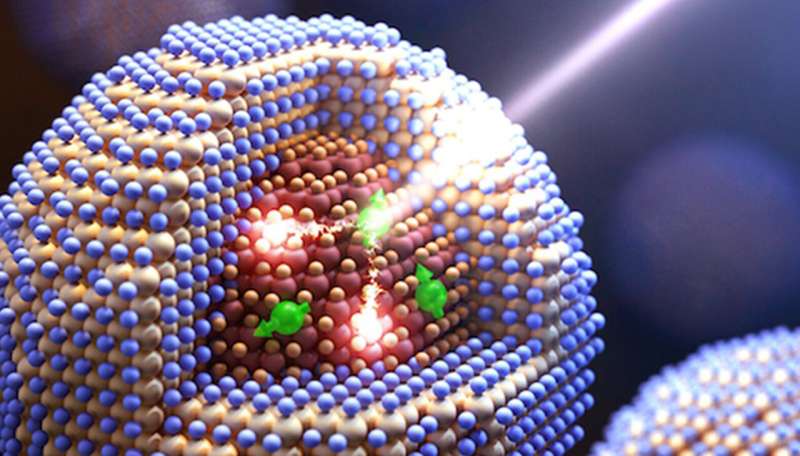This article has been reviewed according to Science X's editorial process and policies. Editors have highlighted the following attributes while ensuring the content's credibility:
fact-checked
trusted source
proofread
New study reveals spin in quantum dots' carrier multiplication

A new approach to developing semiconductor materials at tiny scales could help boost applications that rely on converting light to energy. A Los Alamos-led research team incorporated magnetic dopants into specially engineered colloidal quantum dots—nanoscale-size semiconductor crystals—and was able to achieve effects that may power solar cell technology, photo detectors and applications that depend on light to drive chemical reactions.
"In quantum dots comprising a lead-selenide core and a cadmium-selenide shell, manganese ions act as tiny magnets whose magnetic spins strongly interact with both the core and the shell of the quantum dot," said Victor Klimov, leader of the Los Alamos nanotechnology team and the project's principal investigator. "In the course of these interactions, energy can be transferred to and from the manganese ion by flipping its spin—a process commonly termed spin exchange."
In spin-exchange carrier multiplication, a single absorbed photon generates not one but two electron-hole pairs, also known as excitons, which occur as a result of spin-flip relaxation of an excited manganese ion.
Due to the extremely fast rate of spin-exchange interactions, the magnetically doped quantum dots show a three-fold enhancement in the carrier multiplication yield compared to similarly structured undoped quantum dots. Importantly, the enhancement is especially large in the range of photon energies within the solar spectrum, leading to the possible photoconversion technology applications.
The advantages of carrier multiplication
Normally a photon absorbed by a semiconductor generates an electron in the conduction band and a vacancy in the valence band known as a "hole." This process underlies the operation of photodiodes, image sensors and solar cells wherein the generated charge carriers are extracted as a photocurrent. The photogenerated electrons and holes can also be useful in chemistry where they can facilitate so-called redox reactions that involve electron transfer from one entity to another.
All types of photoconversion schemes would benefit from carrier multiplication, a process triggered by a high-energy photon generating a "hot" carrier with a large kinetic energy. This energy then dissipates in a collision with a valence-band electron by exciting it to the conduction band. As a result, a new electron-hole pair is added to the original pair created by the absorbed photon.
Because of competing energy losses due to interactions with lattice vibrations (usually termed phonons), carrier multiplication is inefficient in bulk solids. However, as Los Alamos researchers first demonstrated in 2004, this effect was enhanced in chemically synthesized colloidal quantum dots. The very small size of colloidal quantum dots increases the frequency of electron-electron collisions and thereby facilitates carrier multiplication.
However, even in the quantum dots, the efficiency of carrier multiplication is not sufficiently high to have an appreciable effect on the performance of practical photoconversion schemes. As in the case of bulk crystals, the primary limitation is energy losses due to fast emission of phonons leading to "nonproductive" heating of a crystal lattice.
Spin-exchange interactions to boost carrier multiplication
Manganese dopants help tackle the problems of fast phonon emission. Building off previous research that demonstrated the sub-picosecond timescales of spin-exchange interactions—which are faster than phonon emission—the researchers realized that using these interactions would boost the efficiency of carrier multiplication.
"In order to enact spin-exchange carrier multiplication, one needs properly engineered quantum dots," said Clement Livache, postdoctoral researcher and spectroscopy expert on the nanotechnology team. "The bandgap of these dots must be less than half of the energy of the manganese spin-flip transition and, further, the spin structure of the quantum dots should match that of the excited manganese ion."
"The energy conditions can be satisfied with manganese-doped quantum dots containing a lead-selenide core and cadmium-selenide shell," said Hin Jo, lead chemist on the project. "In these structures, carrier multiplication occurs via two spin-exchange steps. First, the energy of the electron-hole pair, generated by an absorbed photon in the cadmium-selenide shell, is transferred to the manganese ion. Then, the manganese ion undergoes spin-flip relaxation back to the unexcited state by creating two excitons in the lead-selenide core."
Spin-exchange carrier multiplication can be especially useful in multi-electron/hole reactions that require multiple reduction and oxidation events. One of the bottlenecks in this case is a wait time between sequential reduction and oxidation steps. Carrier multiplication eliminates this bottleneck by producing pairs of charge carriers (two electrons and two holes) co-localized in temporal and spatial domains.
The research is published in the journal Nature Materials.
More information: Ho Jin et al, Spin-exchange carrier multiplication in manganese-doped colloidal quantum dots, Nature Materials (2023). DOI: 10.1038/s41563-023-01598-x
Provided by Los Alamos National Laboratory



















